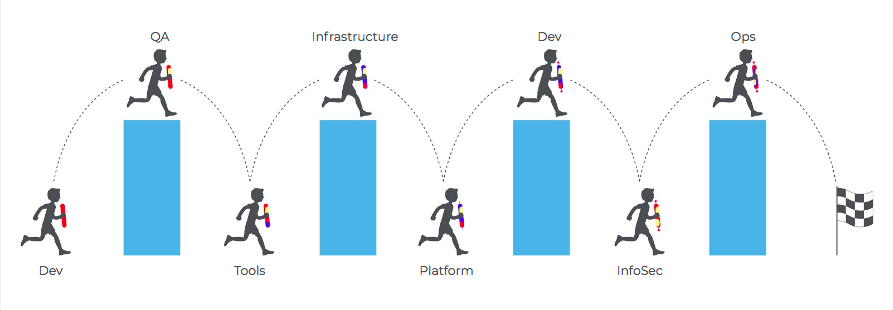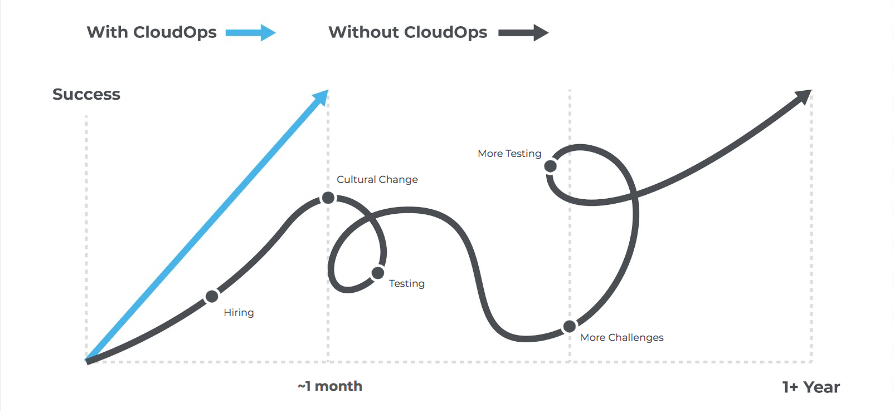Why you Need a DevOps Transformation to Survive

Software is eating the world and organizations are continuously moving towards software-based solutions to their industry’s problems. They are doing so as part of digital transformations that allow them to deliver stronger financial performances.
Cloud is the enabler of this process as it is breaking down non-digital systems and clearing the way for digitally advanced processes and tools to sustain continuous, as-a-service delivery.
Organizations that improve their ability to deliver software are more able to quickly release features, pivot when needed, comply with regulations, and respond to feedback so as to attract new customers and delight existing ones. They can generate more revenue from IT than from mergers and acquisitions or entrepreneurship.1 This value is only accelerating the market demand for app development, which is estimated to outstrip supply fivefold by 2021.2
Containerization has helped drive the development process. It has opened the door for organizations to control cost and take charge of their destinies by leveraging open source tools – specific vendors may not be around forever, so relying on vendors for support instead of intellectual property can lead to more long-term success. By packaging software into standardized, lightweight containers, open source tools like Kubernetes enable software to be executed quickly and efficiently across multi-cloud environments.
Containers are an integral part of cloud native applications, which can be defined as applications that take full advantage of the cloud through being auto-provisioning, auto-scaling, and auto-redundant.
But the ability of containers to promote agility depends on the integration of DevOps cultural practices into CI/CD (continuous integration and delivery) pipelines. Many organizations that embraced containers as a first step to digital transformation are finding themselves held back by traditional IT operations that are unable to sustain the volatility of containerized applications.
Traditional IT
Software releases have traditionally passed through siloed tasks separated by walls of confusion. Product, development, QA, and operations teams are rarely aligned as there is an inherent conflict of interest between developers wanting change and operators wanting stability.
Software releases are delayed as any problem in the delivery pipeline has cascading effects. This results in an overall decrease in release velocity, code quality, and efficiency as well as a release cycle burdened with process. The final features or products released to customers are not in sync with market requirements, which can have dramatically negative impacts on the ability of a business to remain competitive.

DevOps
By empowering developers and operators to take ownership of the entirety of their code and infrastructure stack, DevOps enforces pipelines of continuous integration and delivery (CI/CD) enhanced and synchronized by automation. This streamlines the software development life cycle and increases the frequency and speed of release cycles by saving around 66 hours per developer per year.3
DevOps engineers are responsible for the building, testing, releasing, and operations of their code, instead of overseeing a specific point in the pipeline that all code passes through. This is facilitated by a culture of collaboration, experimentation, and learning.
DevOps is the combination of cultural philosophies, practices, and tools that increase an organization’s ability to deliver applications and services at high velocity. It allows the delivery of stable, high-quality software from concept to customer at high velocity. More of an approach than a specific role, it requires the re-evaluation of an organization’s processes, roles and responsibilities.
Organizations that have successfully made DevOps transformations are returning stronger financial performance. They are evolving and improving products at a faster pace and delivering constant value to customers. DevOps is driving significant changes in value and sustaining the growing need for continuous delivery that underlies digital transformations.
For those reasons, an estimated 47% of CEOs face pressure from their board to digitally transform.4 However, they may overestimate their progress if they focus solely on technologies and neglect the processes. Likewise, they may misdirect their efforts to promote change and encounter severe constraints.
So what’s slowing down DevOps progress?

Trying to hire digital unicorns – Many organizations look to hire digital unicorns as a means to kickstart digital transformation imperatives. Not only can qualified technical talent be difficult to find, but any digital unicorns you do find may be held back by a digital deluge.
Over time, pressure builds as the number of ideas, projects, products, and teams introduced to support these imperatives are slowed down by legacy drag. The culture and decision-making processes are holding back the speed of innovation that DevOps can offer. The infrastructure is aging and the skills being used are becoming dated. Nothing is aligned with the operational models and technologies being introduced, and the digital unicorns are locked behind a dam along with their potential.
Lack of buy-in – Organizations hoping to become DevOps-savvy may lack buy-in from either technical, business or management stakeholders – all are necessary for success and must be aligned in outcome. This will prevent technical teams from being led solely by technology rather than business value and business stakeholders from deciding on technologies that lack long-term viability. Technical teams may be stuck constantly reinventing the wheel as they discuss and experiment with the vast array of tooling available, trying to match technically interesting solutions with business goals.
DevOps predicates transformation both in solutions as well as processes. It requires re-organizing your organizational structure to consist of DevOps engineers who follow code throughout the pipeline as opposed to maintaining siloes. Your technical team must be retrained to become digital unicorns by understanding topics including Infrastructure as Code, containers, secrets management, monitoring, and CI/CD as well as how to work within a pipeline rather than a siloe.
DevOps transformations bring significant value, but require different ways of thinking. Failing to have the right mindset and skills before engineering your delivery pipeline will result in a suboptimal DevOps environment that needs to be refactored multiple times at significant cost.
By assessing your infrastructure and practices, devising a transformation plan, training your team, and providing support throughout the process, CloudOps can help you adopt future-proof solutions and processes in a matter of weeks. This will allow you to circumvent what could be a year of decision-making and experimentation, instead visiting a one-stop shop to optimize how your cloud services are consumed, delivered, and connected.

Click here to learn more about how CloudOps can help your organization move towards a DevOps Transformation.
Resources:
- 1. Bessen, James E. Automation and Jobs: When Technology Boosts Employment. (Boston University School of Law), Law and Economics Paper, n. 17-09, 2017.
- 2. GartnerApps, November, 2016
- 3. Cloudbees, Digital Darwinism: Driving Digital Transformation with DevOps and Continuous Delivery, 2018, https://s3-us-west-2.amazonaws.com/ab-media-prod-01/cloudbees-ab/2018/07/digital_darwinism_with_devops_and_continuous_delivery1.pdf
- 4. Panetta, Kasey, Gartner CEO Survey, 2017.
- 5. Klavens, Elinor, Robert Stroud, Eveline Oehrlich, Glenn O’Donnell, Amanda LeClair, Aaron Kinch, and Diane Kinch, A Dangerous Disconnect: Executives Overestimate DevOps Maturity. (Cambridge, MA), Forrester, 2017.

